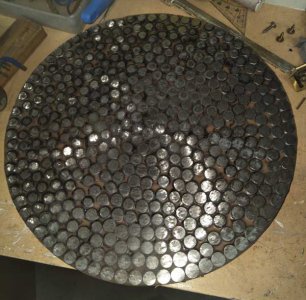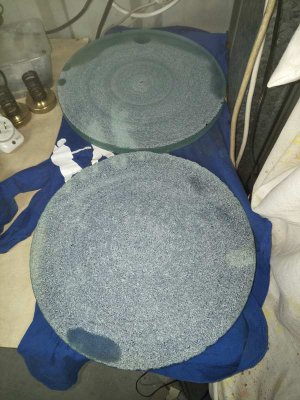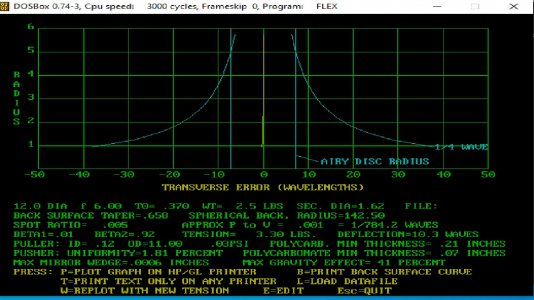- Joined
- Aug 22, 2012
- Messages
- 4,127
The first bit of grinding has started.
The front concave curve of the mirrors need a radius of curvature (roc) of 144", this will be ground in roughly with this abomination of a machine.
The pendulum carries a spinning diamond disk at its end.
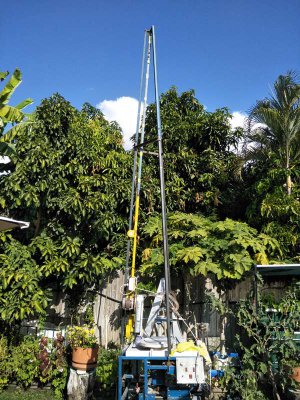
These are the aluminium puller plates rough ground at 122.5" roc concave to marry with the back curve of the mirrors via a 10mm thick foam backing.
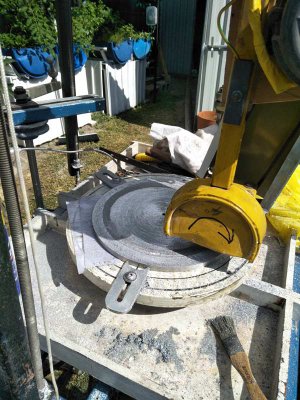
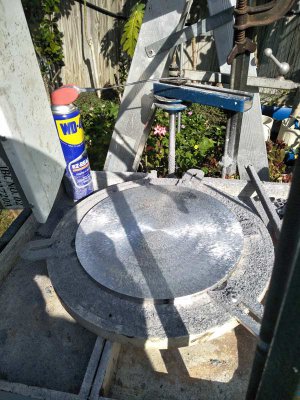
and a close up of how rough it is.
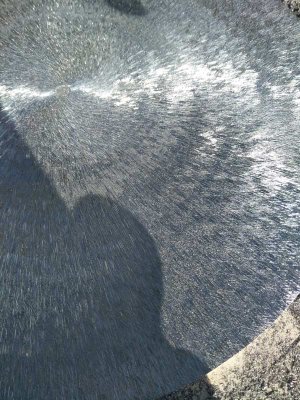
I used a diamond cutting disk with WD40 but was very surprised at how long it took.
(And the mess)
To set it up I set the pendulum at 122.5" from the centre of the top pivot to the edge of the diamond blade.
I then adjust the three tripod legs so the diamond disk "just" kisses the edge of the aluminium disk all around.
Then raise the legs equally till the diamond disk touches about an inch from the centre and start grinding, the aluminium disk rotates anti clockwise pretty fast and the diamond dish rotates clockwise so it cuts against the direction of the main turntable. Lower the pendulum a little and off again, rinse and repeat.
The arrow is to remind me, if I get the direction wrong the diamond disk rides up onto the aluminium disk too fast to control. No big deal but if it happens on the glass mirrors they have a habit of cracking. (dont ask me how I know)
Next is to kiss grind the main tool at 122.5" roc I've just made. Its a large plaster tool, concave ground with steel dumps epoxied to its surface, not set yet so cant run a cleaning grind yet.
The front concave curve of the mirrors need a radius of curvature (roc) of 144", this will be ground in roughly with this abomination of a machine.
The pendulum carries a spinning diamond disk at its end.

These are the aluminium puller plates rough ground at 122.5" roc concave to marry with the back curve of the mirrors via a 10mm thick foam backing.


and a close up of how rough it is.

I used a diamond cutting disk with WD40 but was very surprised at how long it took.
(And the mess)
To set it up I set the pendulum at 122.5" from the centre of the top pivot to the edge of the diamond blade.
I then adjust the three tripod legs so the diamond disk "just" kisses the edge of the aluminium disk all around.
Then raise the legs equally till the diamond disk touches about an inch from the centre and start grinding, the aluminium disk rotates anti clockwise pretty fast and the diamond dish rotates clockwise so it cuts against the direction of the main turntable. Lower the pendulum a little and off again, rinse and repeat.
The arrow is to remind me, if I get the direction wrong the diamond disk rides up onto the aluminium disk too fast to control. No big deal but if it happens on the glass mirrors they have a habit of cracking. (dont ask me how I know)
Next is to kiss grind the main tool at 122.5" roc I've just made. Its a large plaster tool, concave ground with steel dumps epoxied to its surface, not set yet so cant run a cleaning grind yet.


